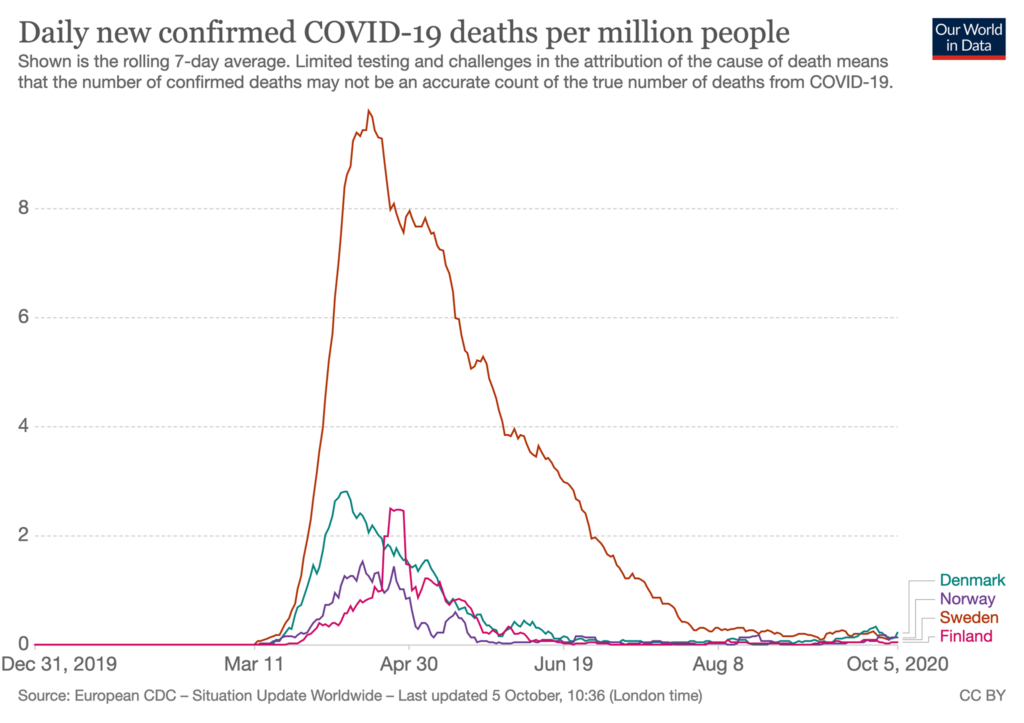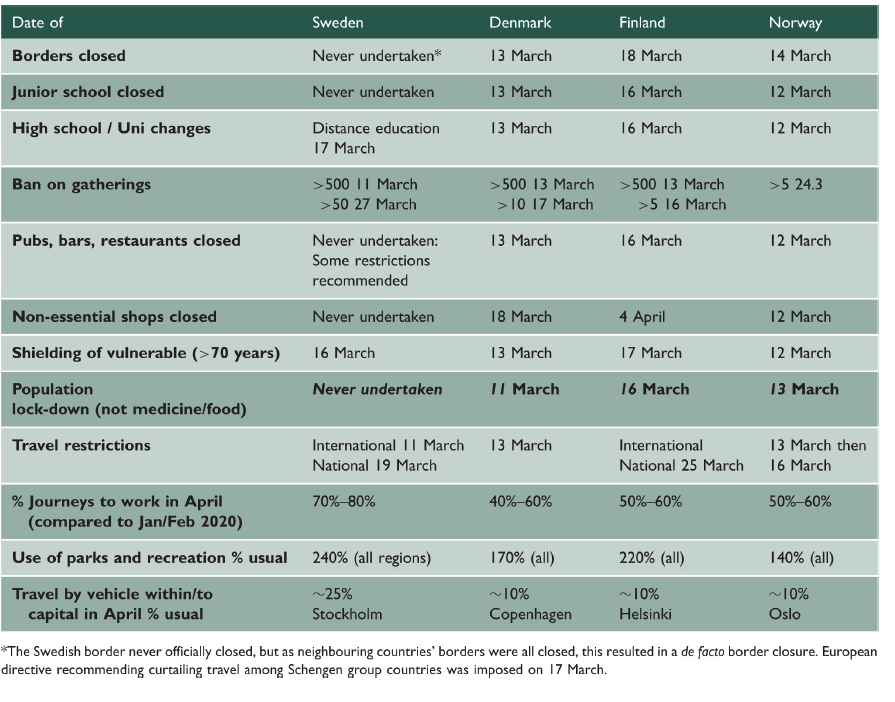A: No, Sweden has not reached herd immunity, nor have they fared well economically or with respect to COVID-19 mortality. Swedes also voluntarily changed behavior more than is frequently assumed.
While there has been a fascination with being Sweden during this pandemic, there are many misconceptions about their experience that are worth clearing up:
*Myth 1*: Sweden didn’t place restrictions on activities due to COVID-19
*Reality*: While it’s true there was no nationwide mandatory lockdowns as in Spain, Italy, the UK and US, Sweden did have a “lockdown lite” including closure of high schools and universities (schools for under 16 stayed open), limits on large gatherings, strong encouragement to work from home and physically distance.
This resulted in a high level of *voluntary* social distancing. Mobile phone data suggests travel in Stockholm fell to 40% of its normal level, though still short of the 20% of other major European cities with mandatory lockdowns.
(See attached Table for differences in COVID-19 measures compared to Scandinavian neighbors.)
*Myth 2*: Sweden is doing well with COVID-19 cases & deaths despite not locking down.
*Reality*: Sweden has suffered dramatically higher mortality than its Nordic neighbors Denmark, Finland, and Norway, all of whom enacted stricter measures early in the outbreak. Sweden has seen almost 5X as many deaths per capita as Denmark, and over 11X more than Norway (See figure).
Sweden does have lower per capita mortality than hardest hit Spain, Italy, the UK, but this is likely due to the timing and intensity of initial infection spread in these locations. Sweden has the worst mortality per capita in Europe after these countries.
Sweden had much higher case levels than its neighbors that were much slower to decline. Like the rest of Europe, Sweden saw a decline in cases over the summer (when things are largely shut down anyway) but has seen significant increases in the past two weeks (see figure).
*Myth 3*: Sweden’s approach saved its economy.
*Reality*: Spending, an indicator of economic activity, since mid-March fell almost as much in Sweden compared to Denmark (25% compared to 29%), but this spending has recovered more quickly in Denmark.
2nd quarter (April-June) GDP in 2020 for Sweden fell 8.3% compared to the same period last year for Sweden, compared to 5.2% in Finland, 5.3% in Norway, and 8.5% in Denmark. Since Sweden’s economy is heavily reliant on exports, it’s not surprising that they would see declines because of the broader pandemic, and it’s possible their economy could have done worse with tighter restrictions. But to date globally the least impacted countries economically have been those who kept a tight lid on infections from the beginning, such as Taiwan (-0.6%) and South Korea (-3.0%).
Our World in Data Link
*Myth 4*: Sweden’s approach got them closer to herd immunity, and they will be safer going forward.
*Reality*: While there is debate about whether this was ever an explicit strategy in Sweden, the lax approach is often taken to mean the goal was herd immunity (see recent DP post on herd immunity here). While there has not been a nationally representative SARS-CoV-2 seroprevalence study in Sweden, estimates from blood donors and other samples find levels in Stockholm of 7-15%, well below the 60-70% estimates for herd immunity. Since most of Sweden is still susceptible, their higher burden of mortality in the first wave did not buy them additional protection due to herd immunity, and their cases are rising again.
*BOTTOM LINE*: The Swedish picture is not as rosy as some have let on. But the full picture will take more time to reveal itself.
It’s important to remember that Sweden’s approach was intended to draw on the high levels of social responsibility and trust in government in Sweden to curtail the disease. This follows the Swedish sociocultural concept of ‘folkvett’; “the common sense of the people as a collective.” Even if effective against the virus, this approach may not be transferable across all countries.
Also, Swedish authorities argued that this more voluntary approach would be more sustainable in the long-run compared to strict lockdowns. While other countries have eased up their restrictions, the recommendations have remained quite stable in Sweden, which may be easier to maintain. We also should remember that given the vagaries of epidemic spread, cross-country comparisons of performance and effectiveness of policies are challenging and require a longer time frame to fully assess.
Given what we know about exponential growth (it gets bad really fast), it could be that *early* but short strict measures are extremely effective at curtailing transmission, a window that Sweden missed compared to its neighbors. More voluntary but clear and consistent measures may work better to keep transmission controlled longer term, but not as an emergency circuit breaker.
Given that a return to full lockdown seems unlikely in Europe or the US even as cases rise, we may all be Sweden now, eventually learning what happens when we rely on the “common sense of the collective” in everyday actions rather than tight restrictions.
We know that our Dear Pandemic followers are strong in this collective common sense—let’s do this!
Love,
Those Nerdy Girls
Further Links on Sweden and COVID-19:
Economic activity in Scandinavia during COVID-19
Summary articles:
“Covid-19: Comparing Sweden’s response with the UK’s is “misleading,” experts argue”
Sweden seroprevalence estimates:
Journal of the Royal Society of Medicine





